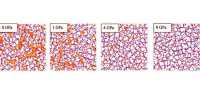Researchers are developing a contagion model to forecast floods in urban environments. A contagion model for forecasting the spread of pandemics has acted as a reference for researchers at Texas A&M University to build a model for predicting the spread and removal of floodwaters through urban highways. Driven by the same modeling and statistical legislation used to forecast the spread of pandemics, researchers at Texas A&M University have developed a mechanism for reliably forecasting the spread and contraction of floodwaters in urban road networks. In this new approach, researchers have established a simple and efficient mathematical approach to a complex problem.
The model can accurately forecast the spread and recession process of floodwaters in urban road networks. The standard way for assessing flood propagation and flood risk in cities involves the use of physics-based hydraulic and hydrologic models, says Ali Mostafavi, Ph.D., Aff.M.ASCE, an associate professor in the Zachry Department of Civil and Environmental Engineering at Texas A&M.
“We were inspired by the fact that the spread of epidemics and pandemics in communities has been studied by people in health sciences and epidemiology and other fields, and they have identified some principles and rules that govern the spread process in complex social networks,” said Dr. Ali Mostafavi, associate professor at the Zachry Department of Civil and Environmental Engineering. “So we ask ourselves, are these spreading processes the same for the spread of flooding in cities? We tested that, and surprisingly, we found that the answer is yes.”
The flexibility of the model is an enormous advantage. The contagion model depends on a “system of differential equations rather than very computationally expensive data-driven models or hydraulic and hydrology models,” says Mostafavi. Despite its simplistic existence, the contagion model will “provide very powerful and accurate predictions.”
The findings of this study were recently published in Nature Scientific Reports.
The contagion model, Susceptible-Exposed-Infected-Recovered (SEIR), is used to mathematically modulate the propagation of infectious diseases. In relation to the floods, Mostafavi and his team have incorporated the SEIR model into a network spread mechanism in which the likelihood of flooding of the road segment depends on the degree to which the surrounding road segments are flooded.
In the case of a flood, a road that may be submerged is vulnerable because it is in a flood plain; a road that is exposed to floods due to rainwater or overflows from a nearby canal; a road that is infected is underwater and cannot be used, and a road that is reclaimed is a road where the floodwater has receded. The study team checked the use of the model with high-resolution historic road flood data in Harris County during Hurricane Harvey in 2017. The findings indicate that the model is capable of tracking and forecasting the progression of flooded roads over time.
“The power of this approach is it offers a simple and powerful mathematical approach and provides great potential to support emergency managers, public officials, residents, first responders and other decision-makers for flood forecast in road networks,” Mostafavi said.
The proposed model will achieve decent precision and recall for the spatial distribution of flooded paths. “If you look at the flood monitoring system in Harris County, you can see if the river is flooding now, but you can’t forecast much for the next four hours or the next eight hours. Also, current flood monitoring systems have little knowledge about the distribution of floods in road networks and the impacts on urban mobility. “In addition to flood prediction in urban networks, the findings of this study provide very important insights about the universality of the network spread processes across various social, natural, physical and engineered systems; this is significant for better modeling and managing cities, as complex systems.”
The only downside to this model of flood prediction is that it cannot identify when the initial flooding will begin, but Mostafavi said there are other systems in place, such as flood gauge sensors, that can fix this.
“As soon as floods are recorded in these areas, our model, which is very simple compared to hydraulic and hydrological models, can be used to estimate the distribution of floods in future hours. The prediction of road flooding and mobility disturbances is crucial to warn people about high-risk roads and to allow emergency management and responders to optimize relief and rescue in affected areas.
Civil engineering doctoral student and graduate research associate Chao Fan led the study and modeling of Hurricane Harvey results, together with Xiangqi (Alex) Jiang, a graduate student in computer science who works at Mostafavi’s UrbanResilience.AI Lab. “By doing this research, I understand the potential of mathematical models to solve technical issues and real-world challenges.
This research extends my research skills and will have a long-term effect on my future,” said Fan. “In addition, I am also very excited that my research can contribute to reducing the negative impacts of natural disasters on infrastructure services.”















